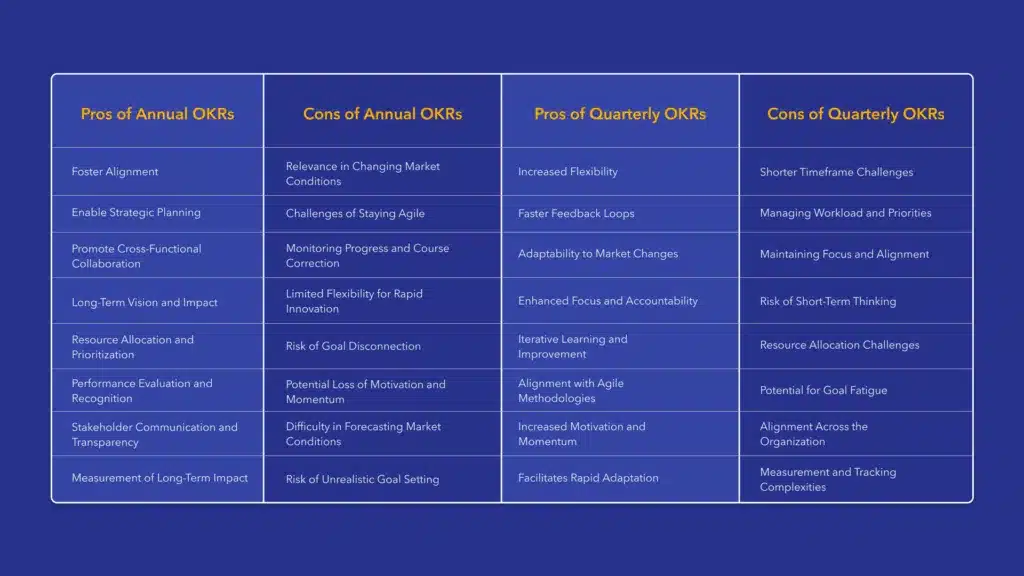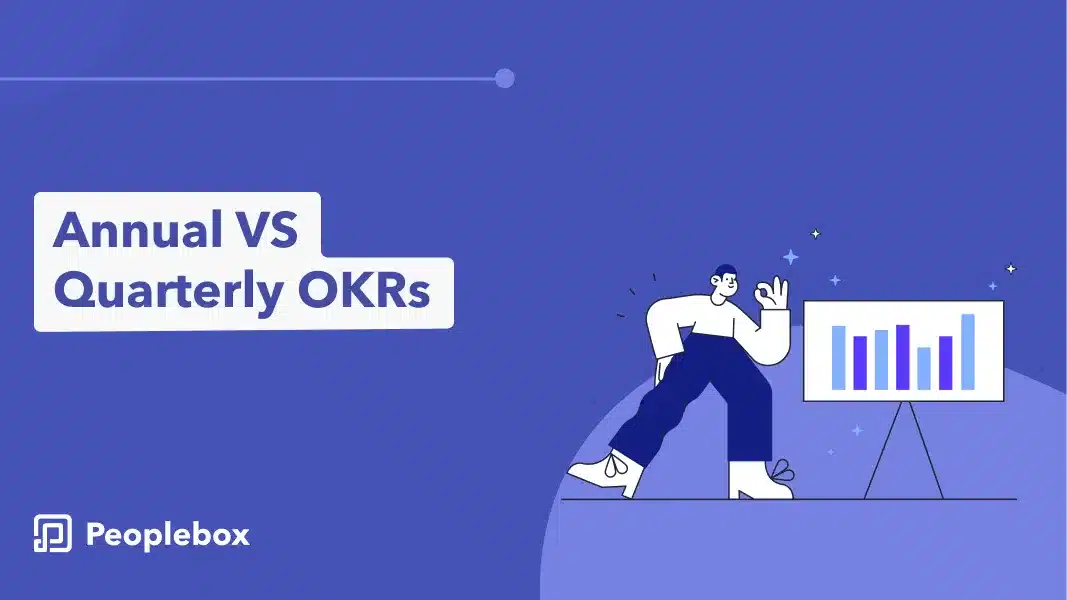When it comes to implementing OKRs, organizations face a critical decision: should they choose annual or quarterly OKRs for their teams?
If you seem to be facing the same annual VS quarterly OKRs setting crisis for your teams, this article is for you. In this piece, we objectively explore the pros and cons of annual and quarterly OKRs, therefore equipping you with the insights needed to make informed decisions.
Whether you’re a CTO, manager, or team lead, understanding these considerations will help you align your goal-setting strategy with your organization’s unique needs and aspirations. So, without any further delays, let’s dive in.
What is Annual OKRs?
Annual OKRs offer a panoramic view of an organization’s goals, enabling the setting of ambitious targets and long-term planning. Research indicates that companies embracing annual OKRs are about 32% more likely to achieve their long-term objectives, highlighting the value of this approach.
However, OKR annual planning comes with challenges. Constant adaptability is a need of an hour. Successful organizations adopt a hybrid approach to address this, blending OKR annual planning with regular reassessment and quarterly check-ins.
Let’s explore further the pros and cons of annual OKRs and embark on a path of continuous growth and accomplishment.
Pros of Annual OKRs
1. Foster Alignment
Annual OKRs provide a long-term perspective, aligning teams and departments towards a shared vision and overarching strategic objectives.
For example, a SaaS company aiming to expand its product offering may set an annual OKR to increase customer retention by 25%. This aligns sales, marketing, and product development teams, fostering collaboration and collective effort.
2. Enable Strategic Planning
The longer time frame of annual OKRs allows for comprehensive strategic planning. Organizations can focus on long-term initiatives, such as entering new markets or launching major product upgrades.
For instance, a B2B manufacturing company can set an annual OKR to diversify its product line by introducing three new offerings. This enables careful resource allocation, market research, and product development cycles.
3. Promote Cross-Functional Collaboration
Annual OKRs encourage cross-functional collaboration and break down silos within organizations. By aligning objectives across departments, teams can work together towards shared outcomes.
For example, consider a fintech company with an annual OKR to improve customer onboarding experience. This objective involves collaboration between product, design, engineering, and customer success teams, leading to a cohesive and seamless user journey.
4. Long-Term Vision and Impact
Annual OKRs allow setting goals that have a significant and lasting impact on the organization.
For instance, a healthtech company may set an annual OKR to reduce patient wait times by implementing streamlined processes and leveraging technology, improving overall patient experience and satisfaction.
5. Resource Allocation and Prioritization
Annual OKRs allow organizations to allocate resources effectively by providing a clear roadmap for investment and prioritization.
For example, a B2B manufacturing company can use annual OKRs to prioritize research and development efforts for a new product line, ensuring optimal allocation of financial and human resources.
6. Performance Evaluation and Recognition
Annual OKRs enable comprehensive performance evaluation and recognition. By reviewing progress and achievements at the end of the year, organizations can reward employees and teams for their contributions. This recognition fosters a sense of accomplishment, boosts morale, and motivates individuals to strive for excellence.
An example could be a B2B technology company recognizing a team’s successful implementation of a major software upgrade, resulting in improved efficiency and customer satisfaction.
7. Stakeholder Communication and Transparency
Annual OKRs provide a framework for transparent communication with stakeholders, including investors, clients, and board members. Sharing annual objectives and progress updates demonstrates a commitment to organizational growth and instills stakeholder confidence.
For instance, a financial services firm may share annual OKRs related to regulatory compliance and risk management to showcase its commitment to responsible operations.
8. Measurement of Long-Term Impact
Annual OKRs enable organizations to measure the long-term impact of their efforts. By tracking key results over a year, organizations can assess the effectiveness of their strategies and make data-driven decisions for future planning.
For example, a marketing agency may use annual OKRs to measure the growth in brand awareness and lead generation, helping them evaluate the success of their marketing campaigns.
Cons of Annual OKRs
1. Relevance in Changing Market Conditions
Annual OKRs may become less relevant as market conditions evolve. In fast-paced industries, the business landscape can shift significantly within a year. Therefore, organizations must continuously monitor market dynamics and be prepared to adapt or realign their objectives.
For instance, a B2B e-commerce platform with an annual OKR to capture a specific market segment must remain vigilant to emerging competitors or disruptive technological advancements.
2. Challenges of Staying Agile
The longer time frame of annual OKRs poses challenges in staying agile and responsive to emerging opportunities or threats. Organizations must strike a balance between setting ambitious goals and maintaining flexibility.
For example, a software development company may need help if an annual OKR restricts the adoption of new technologies or inhibits pivoting to address market demands.
3. Monitoring Progress and Course Correction
Annual OKRs require diligent tracking, progress monitoring, and course correction throughout the year. With regular check-ins and reviews, organizations can maintain their objectives and progress.
A B2B consulting firm with an annual OKR to increase client satisfaction must establish frequent feedback loops and performance evaluation processes to ensure continuous improvement and course correction.
4. Limited Flexibility for Rapid Innovation
The longer time frame of annual OKRs can limit the ability to respond quickly to disruptive market trends or technological advancements. Organizations must balance the need for long-term planning with the need for rapid innovation and adaptation.
For example, a software startup may need help if an annual OKR restricts the exploration of emerging technologies or impedes its ability to pivot based on customer feedback.
5. Risk of Goal Disconnection
As market dynamics evolve, there is a risk that annual OKRs may become disconnected from the changing realities and priorities of the organization. Regular reviews and recalibration are necessary to mitigate the risk to ensure ongoing alignment with the strategic direction.
For example, a B2B logistics company with an annual OKR to expand into a new geographic market may need to reassess its goals if geopolitical factors or economic conditions change.
6. Potential Loss of Motivation and Momentum
The longer duration of annual OKRs can sometimes lead to a loss of motivation and momentum as the year progresses. To combat this, organizations must implement regular check-ins, progress updates, and celebrations of milestones to keep teams engaged and energized.
For example, a B2B sales team may experience a dip in motivation if there is no frequent recognition of their progress toward annual revenue targets.
7. Difficulty in Forecasting Market Conditions
Annual OKRs require accurate forecasting of market conditions and customer behaviors over a longer time horizon. Unexpected market shifts or disruptions can impact the achievability of annual goals. Organizations must continuously monitor market trends and leverage data-driven insights to mitigate this risk.
For example, a SaaS company may need help if an annual OKR is based on a projected market growth that doesn’t materialize.
8. Risk of Unrealistic Goal Setting
Setting overly ambitious annual OKRs without a realistic assessment of available resources and market conditions can lead to frustration and demotivation. It is essential to balance setting stretch goals and ensuring they are attainable.
For example, a B2B professional services firm must carefully consider its workforce’s capacity and capabilities when setting annual OKRs to avoid setting unachievable targets.
Considering these pros and cons, you can make informed decisions maximizing the effectiveness of this goal-setting framework.
What are Quarterly OKRs?
Quarterly OKRs provide organizations with the flexibility to respond swiftly to market changes, seize emerging opportunities, and meet evolving customer demands. By aligning goals with shorter time horizons, organizations foster an agile culture of continuous improvement.
However, remember that quarterly OKRs require disciplined planning and execution to ensure progress toward long-term strategic objectives. Balancing short-term wins with broader company goals is crucial. Clear communication, regular progress updates, and continuous tracking play a vital role in maximizing the effectiveness of quarterly OKRs.
By exploring the pros and cons of quarterly OKRs, organizations can harness their power to drive growth, innovation, and sustainable success.
Pros of Quarterly OKRs
1. Increased Flexibility
Quarterly OKRs allow for more frequent reassessment and adjustment of goals. Organizations can quickly respond to changing market conditions, emerging opportunities, and customer feedback.
For example, a tech company can set a quarterly OKR to enhance its cybersecurity measures based on recent industry trends and evolving threats. This flexibility ensures that goals remain relevant and aligned with the current business landscape.
2. Faster Feedback Loops
The shorter time frame of quarterly OKRs enables more frequent feedback loops, fostering a culture of continuous improvement. Teams can receive timely feedback, identify areas of improvement, and make necessary adjustments to optimize performance.
For example, in a marketing agency, a quarterly OKR to improve lead conversion rates allows teams to implement strategies, measure results, and refine tactics based on real-time feedback.
3. Adaptability to Market Changes
Quarterly OKRs facilitate better adaptability to market changes and emerging opportunities. Organizations can pivot their strategies, explore new directions, and capitalize on market trends within shorter cycles.
For example, consider a software development company that sets a quarterly OKR to explore partnerships with emerging technology startups. This agile approach enables them to seize opportunities as they arise and stay ahead of the competition.
4. Enhanced Focus and Accountability
Quarterly OKRs promote a heightened sense of focus and accountability as teams work towards achieving specific objectives within shorter timeframes.
This concentrated effort fosters a results-oriented mindset and ensures that progress is regularly monitored and measured.
5. Iterative Learning and Improvement
Quarterly OKRs facilitate an iterative learning process, allowing teams to experiment, learn from successes and failures, and continuously improve.
This iterative approach enables organizations to adapt their strategies and tactics based on real-time insights and feedback.
6. Alignment with Agile Methodologies
Quarterly OKRs align well with agile methodologies, such as Kanban or Scrum, where work is organized into short sprints or iterations.
The iterative nature of Quarterly OKRs complements the agile mindset and enables teams to deliver incremental value while adapting to evolving customer needs and market dynamics.
7. Increased Motivation and Momentum
The shorter timeframe of Quarterly OKRs creates a sense of urgency and fosters momentum within teams. It provides regular opportunities for celebrating wins, boosting morale, and maintaining motivation throughout the year.
Quick wins and tangible progress contribute to a positive and energized work environment.
8. Facilitates Rapid Adaptation
Quarterly OKRs enable organizations to respond more to market changes and emerging trends. With shorter cycles, teams can quickly pivot strategies, seize new opportunities, and address unforeseen challenges.
This adaptability is especially beneficial in industries with high volatility or disruptive innovation.
Cons of Quarterly OKRs
1. Shorter Timeframe Challenges
The shorter duration of quarterly OKRs can pose challenges in achieving complex or long-term goals. Some objectives require a longer time horizon for significant progress. Therefore, organizations must carefully balance the pursuit of short-term wins with aligning quarterly objectives with broader strategic goals.
For instance, a B2B logistics company aiming to establish a global distribution network may need help to achieve substantial milestones within a single quarter.
2. Managing Workload and Priorities
Quarterly OKRs demand effective workload management and prioritization. With shorter cycles, teams must deliver on multiple objectives simultaneously without compromising quality or burning out employees.
For example, a software development team may need to balance feature enhancements, bug fixes, and technical debt reduction within a single quarter while aligning with overall company goals.
3. Maintaining Focus and Alignment
Quarterly OKRs require ongoing focus and alignment to prevent distractions or veering off track. Regular check-ins, progress reviews, and transparent communication are vital to keep teams accountable and ensure everyone remains aligned with the overarching objectives.
A B2B sales organization with a quarterly OKR to increase revenue must continuously monitor progress, address potential bottlenecks, and foster collaboration across sales teams.
4. Risk of Short-Term Thinking
The shorter time horizon of Quarterly OKRs may encourage a myopic focus on short-term gains, potentially neglecting long-term strategic objectives.
Organizations must balance achieving immediate results and aligning with broader, overarching goals.
5. Resource Allocation Challenges
Quarterly OKRs require careful resource allocation to ensure teams can effectively work on multiple objectives simultaneously.
Competing priorities, limited resources, and conflicting OKRs within a quarter can strain teams and impact overall productivity and performance.
6. Potential for Goal Fatigue
Frequent goal-setting cycles may lead to goal fatigue, particularly if teams are constantly shifting focus and objectives.
This can impact morale and motivation, making it essential to balance maintaining momentum and avoiding burnout.
7. Alignment Across the Organization
Coordinating Quarterly OKRs across different teams and departments can be challenging.
Ensuring that individual objectives align with company-wide goals and contribute to the overall strategy requires effective communication, collaboration, and alignment mechanisms.
8. Measurement and Tracking Complexities
Tracking progress and measuring outcomes within shorter timeframes can pose measurement complexities.
Organizations need robust tracking systems and clear metrics to accurately assess performance and determine the impact of Quarterly OKRs on overall organizational success.
Considering these pros and cons, you can make informed decisions regarding adopting and implementing quarterly OKRs. Understanding them well with this goal-setting framework will enable organizations to leverage their advantages while effectively mitigating potential obstacles.
Comparison table summarizing the pros and cons of annual and quarterly OKRs

Maximize Your OKR Strategy with Peoplebox: Embrace the Power of Annual vs Quarterly OKRs
At Peoplebox, we understand the importance of tailoring your approach to align with your specific needs. With our comprehensive OKR platform, you can optimize your goal management using both annual and quarterly strategies.
With annual OKRs, you gain a longer-term perspective, fostering alignment and strategic planning. It enables resource allocation, priority setting, and recognition of long-term impact.
On the other hand, quarterly OKRs bring agility and faster feedback loops. They allow adaptability, focus, and motivation, delivering tangible results within a shorter time frame.
With Peoplebox as your partner, you can leverage the benefits of both approaches. Our platform empowers you to monitor progress, set ambitious goals, and drive remarkable results.
Ready to elevate your goal management?
Book a demo with Peoplebox today and embark on a journey towards optimized performance and organizational success.






